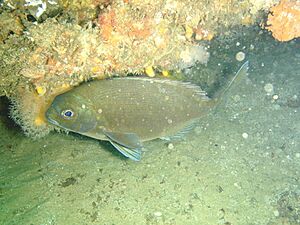Bronze seabream facts for kids
Quick facts for kids Bronze seabream |
|
|---|---|
 |
|
| Conservation status | |
| Scientific classification | |
| Synonyms | |
|
The Pachymetopon grande, often called the bronze seabream or blue hottentot, is a type of fish found in the ocean. It belongs to the family called Sparidae, which includes many kinds of seabreams and porgies. This fish lives in the southwestern Indian Ocean. It's an important fish for people who enjoy fishing for sport in South Africa. It's also caught by people who fish to feed their families.
Contents
What is the Bronze Seabream?
The bronze seabream's scientific name is Pachymetopon grande. A scientist named Albert Günther first officially described it in 1859. He was a German-born British expert who studied fish. He found this fish near the Cape of Good Hope in South Africa. Günther even created a new group, or genus, just for this fish, called Pachymetopon.
Why is it Called "Grande"?
The specific name for this fish is grande. This word means "large" in some languages. The scientist who named it, Günther, didn't explain why he chose this name. It might be because of a large bump between its eyes. Or, it could simply be because the fish itself can grow quite big.
What Does the Bronze Seabream Look Like?
The bronze seabream has a round, deep body. Its body is about 2 to 2.3 times deeper than its length. The top of its head is smooth and curved. It has a small bump right in front of its eyes.
Its top fin, called the dorsal fin, has 11 stiff spines and 11 to 13 soft rays. The fin underneath, the anal fin, has 3 spines and 10 or 11 soft rays. The fish's body is mostly a bronze color. Its belly and chest are lighter. Its head and side fins are a shiny blue color. This fish can grow up to 65 centimeters (about 25 inches) long. However, most of them are usually around 35 centimeters (about 14 inches) long.
Where Does the Bronze Seabream Live?
The bronze seabream lives only in Southern Africa. You can find it from Southern Mozambique all the way to False Bay in the Western Cape. It has also been seen near southern Madagascar. These fish prefer shallow waters, usually less than 25 meters (about 82 feet) deep. They like to live in rocky areas where they can find food and shelter.
What Does the Bronze Seabream Eat and How Does it Live?
The bronze seabream is an omnivore, meaning it eats both plants and animals. It grazes on algae, which are like sea plants. It also eats small animals that live on the seafloor. Young bronze seabreams eat more small crustaceans, like tiny crabs, than the adult fish do.
These fish become ready to reproduce when they are about 5.5 years old. They lay their eggs between January and June in the Eastern Cape. In KwaZulu-Natal, they lay eggs in winter. They probably lay their eggs in small groups. This usually happens in the mornings and evenings. Adult bronze seabreams tend to stay in one place and do not move around much.
Why is the Bronze Seabream Important to Protect?
The bronze seabream is a popular fish for people who fish for fun from the shore. It's also caught by spear fishers. It is not usually caught by large commercial fishing boats. However, people who fish to feed their families in the Eastern Cape do catch them.
This fish grows slowly and lives a long time. It also doesn't move around much. These traits make it easy for too many of them to be caught. Scientists have noticed that the number of bronze seabreams has gone down a lot. To help protect them, there are rules in place. Fishers can only keep fish that are at least 30 centimeters (about 12 inches) long. They can also only catch 2 fish per day.
When these fish are protected in special areas, like Marine protected areas, their numbers increase. The IUCN (International Union for Conservation of Nature) lists this fish as a Near-threatened species. This means it could become endangered if we don't protect it.


